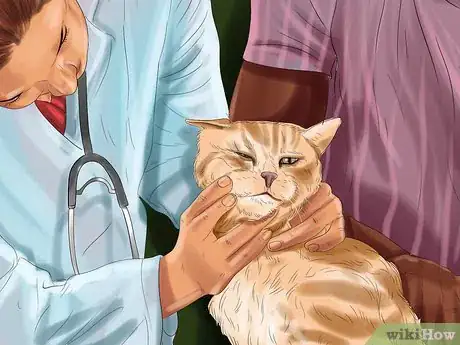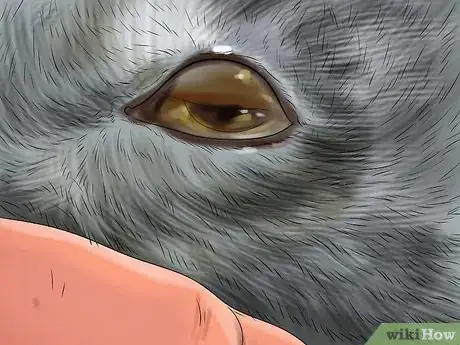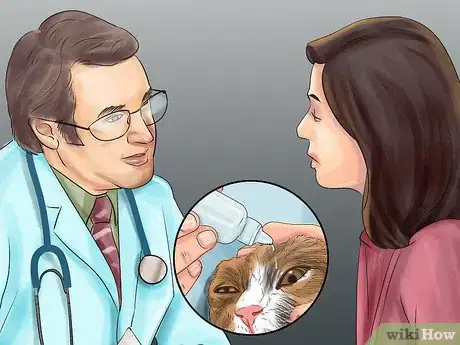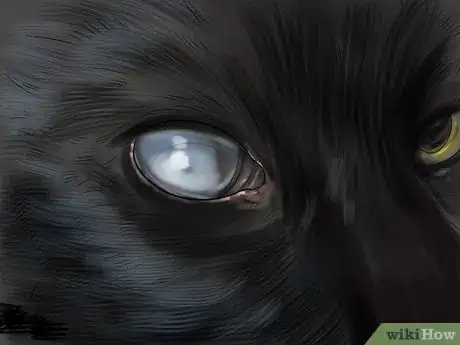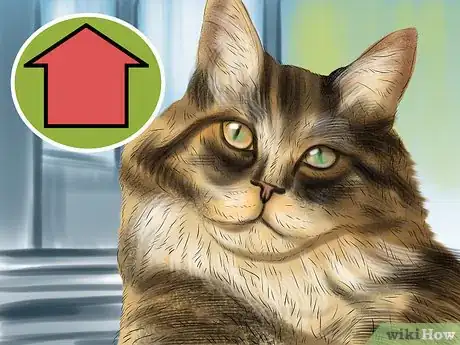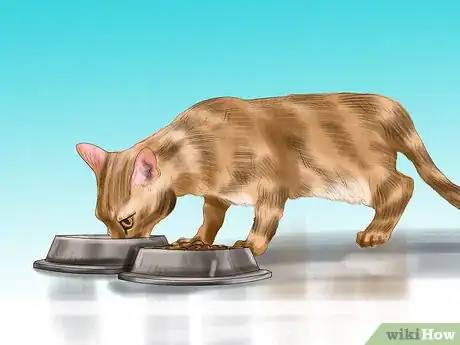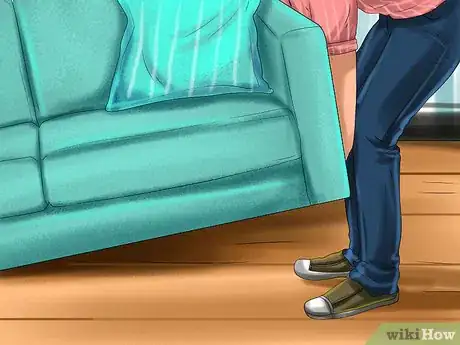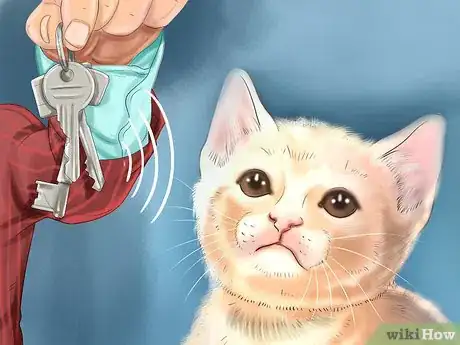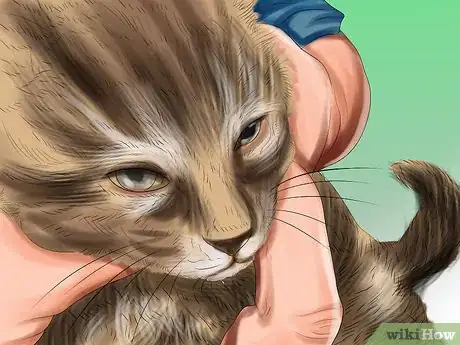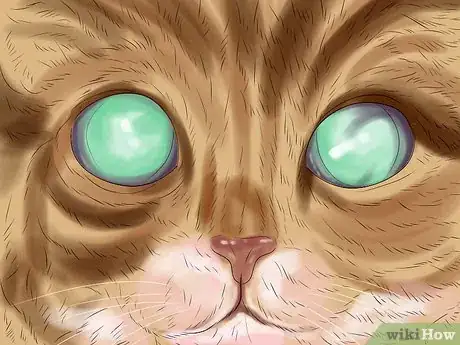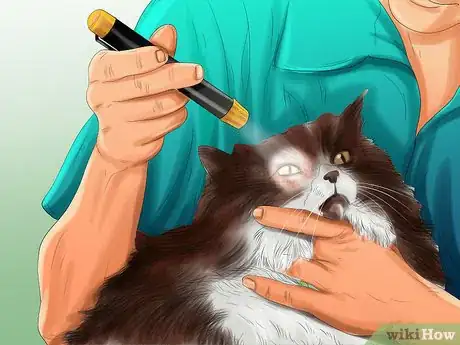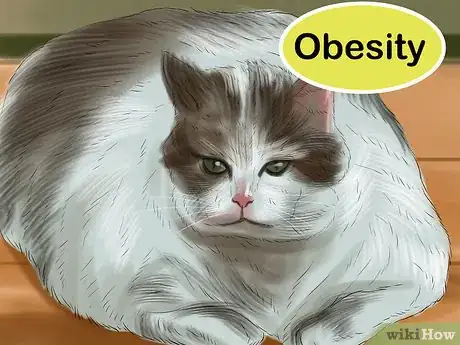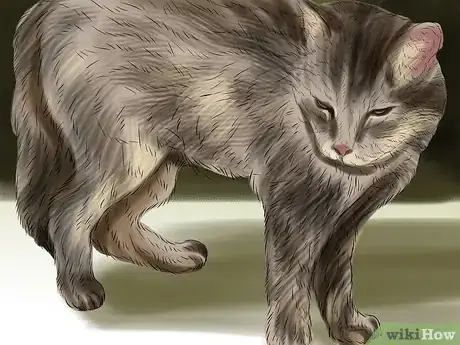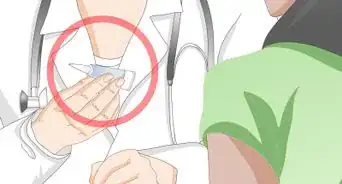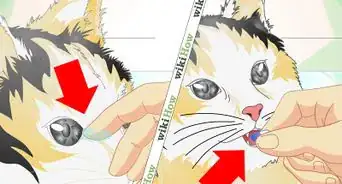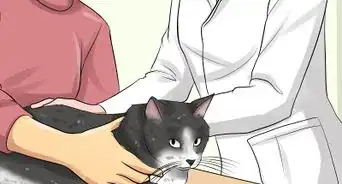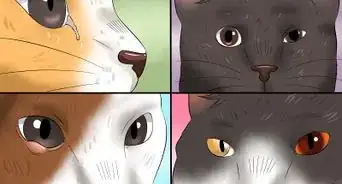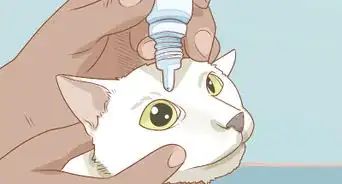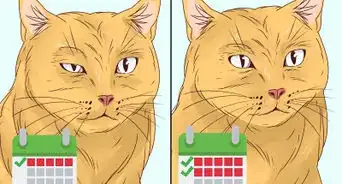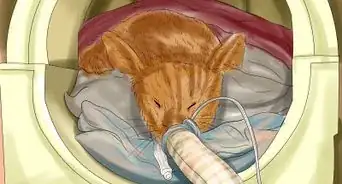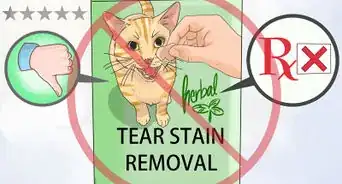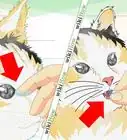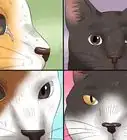This article was co-authored by Pippa Elliott, MRCVS. Dr. Elliott, BVMS, MRCVS is a veterinarian with over 30 years of experience in veterinary surgery and companion animal practice. She graduated from the University of Glasgow in 1987 with a degree in veterinary medicine and surgery. She has worked at the same animal clinic in her hometown for over 20 years.
There are 12 references cited in this article, which can be found at the bottom of the page.
wikiHow marks an article as reader-approved once it receives enough positive feedback. In this case, 94% of readers who voted found the article helpful, earning it our reader-approved status.
This article has been viewed 23,147 times.
Vision problems are common in senior cats. However, there are plenty of steps you and your cat’s vet can take to keep your older cat happy and healthy. Check your cat’s eyes every one to two weeks. Look for cloudiness, enlargement, redness, or discharges. Take note if it paws or scratches at its eyes or if it seems to wander aimlessly or bumps into objects. Bring it to the vet at the first sign of problems, and have it examined annually. If your cat is losing its vision or blind, keep it inside, avoid switching around your furniture, and make sure it can easily access its food, water, toys, and litter box.
Steps
Consulting a Veterinarian
-
1Take your cat to the vet at least once a year. Annual vet exams are essential to maintaining the health of your senior cat. Some vision problems are associated with underlying conditions, like high blood pressure or hyperthyroidism, and only proper veterinary care can deal with these conditions.[1] Others, like glaucoma, progress gradually and subtly, making it difficult to spot them when you check your cat’s eyes on your own.[2]
- An older cat should have check-ups at least every 6 months.
-
2Get your cat examined as soon as you notice any signs of vision problems. You should check your senior cat’s eyes on a weekly or biweekly basis. As a general rule, you should not have a “wait and see” attitude when it comes to cat eye problems. Bringing your cat to the vet at the first sign of vision problems could spare it significant pain and save its vision.[3]Advertisement
-
3Discuss appropriate medications with the vet. The vet will most likely prescribe eye drops to treat infections or relieve the symptoms of glaucoma. It can be a frustrating process, but you’ll have to hold the cat down, open its eyelid, hold the dropper just above the eye (without touching it) to administer the medication, then keep the cat still for several minutes.
- Ask the vet to show you firsthand how to give your cat eye drops or if they have any tips.
- The main cause of vision problems in older cats is high blood pressure. The vet will test for high blood pressure and will likely run a blood test to check for other underlying issues. The vet will also examine the back of the eye -- the retina -- to look for signs of hemorrhage or separation of the retina.
- The vet may prescribe oral medications to treat high blood pressure, kidney disease, hyperthyroidism, and other underlying causes of vision problems. Make sure you administer any medication as directed by the vet.[4]
-
4Ask about treating cataracts or having them removed. There are medications that can delay cataract-related blindness. Cataracts can also result from high blood pressure or diabetes, so ask the vet if they recommend treatment for these conditions. If a cataract has completely blocked light from passing through the lens, the vet might recommend surgery.[5]
- Cataract surgery is usually more common in kittens and in mature cats under age 10. If you’re considering surgery for your senior cat, ask the vet, “Is my cat a qualified candidate for lens replacement? Do the risks and costs make surgery a less desirable option?”
- It might be preferable to take steps to make your senior cat more comfortable instead of taking on the risks and expenses associated with surgery.
Making Your Older Cat More Comfortable
-
1Keep your cat inside if its vision is failing. You should stop letting your indoor/outdoor cat go outside if you notice signs that it’s losing its vision. All cats, especially those with vision and other health problems, are safer indoors. A cat with poor eyesight will have a harder time steering clear of threats like cars and other animals.[6]
-
2Make sure you cat can access its food and water. Cats typically adapt well to vision loss by relying on their hearing, smell, and whiskers to navigate their surroundings. You should make sure it knows where its food and water bowls are located. If necessary, bring it to its food and hold its paw to feel where the bowls are set.[7]
- Be sure to keep its food and water in one spot. Don’t change the location of your senior cat’s food and water.
-
3Keep a litter box on each of your home’s floors. If your senior cat is blind or has poor eyesight, it’s best to keep it on one floor, as stairs can pose an injury risk. If your cat does move around multiple floors, keep a litter box upstairs and downstairs to prevent accidents.[8]
- Senior cats often develop arthritis, so consider using litter boxes with shorter sides for easier access. Make sure your cat knows where its litter boxes are located and keep them in those locations.
-
4Avoid switching around your furniture. Other senses, whiskers, and memory will help your blind or vision impaired cat move around your house. However, you should do your best to make sure its environment is consistent. Avoid changing around your furniture or introducing new obstacles to your cat’s surroundings.[9]
-
5Use sound to avoid startling your cat. It's easy to accidentally sneak up on a blind or visually impaired cat, so you should take steps to avoid startling it. When you approach it, call its name so it knows you're coming. Only pick it up if it knows that you're nearby and you are already interacting with it.
Diagnosing and Delaying Vision Problems
-
1Look for signs of gradual blindness or vision loss. Observe your cat when it’s walking around your home. Look for aimless wandering, bumping into objects, and trouble finding its food and water bowls.[10] See if it has any trouble following its toys, like a feather on a fishing pole, during playtime.[11]
- These could indicate gradual blindness or vision loss. Having it examined by a vet will give you an accurate diagnosis. Cats adapt well to vision loss as they age, but you should take steps to make sure it can easily access it food, water, toys, and litter box.
-
2Check the eyes regularly for cloudiness and enlargement. Look for cloudiness in one or both eyes, with or without enlargement. These signs could indicate that your cat has glaucoma. Glaucoma isn’t one specific disease, but a condition caused by blocked drainage ducts and fluid buildup that puts pressure on the optic nerve.[12]
- Symptoms usually develop gradually, so they can be hard to spot. If you do notice any enlargement in one or both eyes, you should bring your cat the vet immediately.
- Checking your cat’s eyes regularly at home, calling the vet at the first sign of any problems, and getting annual vet exams are the best ways to diagnose and treat glaucoma and other vision problems.
- Glaucoma can be painful and cause blindness, but there are medications that can relieve the pain and reduce fluid pressure.
-
3Check your cat’s eyes regularly for opaque haziness. Point a flashlight indirectly at your cat’s eyes and check for opaque or milky haziness in the irises, or colored parts. Whitish, milky haziness is a sign that a cataract is developing on the lens, blocking light from reaching the retina.[13]
- A bluish-white haze, rather than milky and opaque, is due to lenticular sclerosis, which is when the lens starts to lose moisture. This is a normal part of aging that typically appears in cats over age 10 and rarely requires treatment.
- Cataracts are less common in cats than in dogs or humans, but you should bring your cat to the vet if you spot any abnormalities.
-
4Look for dilated pupils and changes in night vision. Notice if your cat’s pupils are always widely dilated and if it seems hesitant to enter a dark room. These could point to retinal atrophy or detachment. These conditions result from degeneration of the retina or of the tissue that holds it in place.[14]
- Retinal atrophy and detachment are usually associated with high blood pressure, kidney disease, or an overactive thyroid gland. Seeing a vet promptly is vital to treating both the retinal disorder and the underlying condition that causes it.[15]
-
5Check for redness, crustiness, and discharges. Cats’ eyes are prone to a number of treatable infections, and an older cat’s weaker immune system can make them more vulnerable. Check for signs of infection like redness, crusty buildup, discharges, and swollen third eyelids. Take note if you see your cat repeatedly pawing or scratching at its eyes.[16]
- Infections like conjunctivitis and keratitis are usually treated with eyedrops. Complications don’t often develop, especially with prompt treatment.
- Uveitis, or infection of the middle area of the eye, is more serious and usually leads to gradual blindness. Signs of uveitis include eye enlargement and swollen third eyelids.[17]
-
6Prevent eye infections by vaccinating your cat. Eye infections are often associated with germs like feline immunodeficiency virus and feline herpesvirus. Getting your cat vaccinated when it’s young is vital to preventing vision problems and other health issues later in life.[18]
- Even if you have a mature cat, talk to its vet about getting it vaccinated.
-
7Prevent your cat from becoming obese. Feeding your cat a healthy diet can help prevent kidney and heart conditions that can cause or worsen vision problems. If your cat gains weight, consider feeding it twice a day instead of leaving food out. Make sure treats account for less than 10 percent of its daily calories.[19]
-
8Make sure your cat doesn't become underweight. Losing too much weight can also put stress on the kidneys and other organs. If your senior cat is underweight, you might have to switch its food to a higher calorie variety, like food marked for kittens. Talk to its vet about the healthiest ways to help your cat gain weight.[20]
Expert Q&A
-
QuestionCan a cat suddenly go blind?
 Pippa Elliott, MRCVSDr. Elliott, BVMS, MRCVS is a veterinarian with over 30 years of experience in veterinary surgery and companion animal practice. She graduated from the University of Glasgow in 1987 with a degree in veterinary medicine and surgery. She has worked at the same animal clinic in her hometown for over 20 years.
Pippa Elliott, MRCVSDr. Elliott, BVMS, MRCVS is a veterinarian with over 30 years of experience in veterinary surgery and companion animal practice. She graduated from the University of Glasgow in 1987 with a degree in veterinary medicine and surgery. She has worked at the same animal clinic in her hometown for over 20 years.
Veterinarian Sadly, yes, some cats do go blind suddenly, such as overnight. Most often this is due to high blood pressure causing fluid to push the retina away from the back of the eye (known as retinal detachment). For this reason, any cat that suddenly goes blind should see a vet and have their blood pressure checked as hypertension needs treatment
Sadly, yes, some cats do go blind suddenly, such as overnight. Most often this is due to high blood pressure causing fluid to push the retina away from the back of the eye (known as retinal detachment). For this reason, any cat that suddenly goes blind should see a vet and have their blood pressure checked as hypertension needs treatment -
QuestionHow can I tell if my cat has vision problems?
 Pippa Elliott, MRCVSDr. Elliott, BVMS, MRCVS is a veterinarian with over 30 years of experience in veterinary surgery and companion animal practice. She graduated from the University of Glasgow in 1987 with a degree in veterinary medicine and surgery. She has worked at the same animal clinic in her hometown for over 20 years.
Pippa Elliott, MRCVSDr. Elliott, BVMS, MRCVS is a veterinarian with over 30 years of experience in veterinary surgery and companion animal practice. She graduated from the University of Glasgow in 1987 with a degree in veterinary medicine and surgery. She has worked at the same animal clinic in her hometown for over 20 years.
Veterinarian Simple tests include dropping a cotton wool ball in front of the cat to see if they follow it. Be careful not to let the cotton ball touch the cat's whiskers. Also, watch the size of the cat's pupils. If they are big and round, and stay this way even in bright sunlight, this could indicate a problem with eyesight.
Simple tests include dropping a cotton wool ball in front of the cat to see if they follow it. Be careful not to let the cotton ball touch the cat's whiskers. Also, watch the size of the cat's pupils. If they are big and round, and stay this way even in bright sunlight, this could indicate a problem with eyesight. -
QuestionCan blindness in cats be reversed?
 Pippa Elliott, MRCVSDr. Elliott, BVMS, MRCVS is a veterinarian with over 30 years of experience in veterinary surgery and companion animal practice. She graduated from the University of Glasgow in 1987 with a degree in veterinary medicine and surgery. She has worked at the same animal clinic in her hometown for over 20 years.
Pippa Elliott, MRCVSDr. Elliott, BVMS, MRCVS is a veterinarian with over 30 years of experience in veterinary surgery and companion animal practice. She graduated from the University of Glasgow in 1987 with a degree in veterinary medicine and surgery. She has worked at the same animal clinic in her hometown for over 20 years.
Veterinarian This depends on the cause of the blindness. A common cause of sudden blindness is high blood pressure. If this is identified immediately (i.e. as soon as the cat becomes blind) then prompt treatment may reduce the amount of fluid at the back of the eye which causes the retinal separation and loss of vision.
This depends on the cause of the blindness. A common cause of sudden blindness is high blood pressure. If this is identified immediately (i.e. as soon as the cat becomes blind) then prompt treatment may reduce the amount of fluid at the back of the eye which causes the retinal separation and loss of vision.
References
- ↑ http://catinfo.org/feline-hyperthyroidism/
- ↑ https://www.vet.cornell.edu/departments-centers-and-institutes/cornell-feline-health-center/health-information/feline-health-topics/feline-glaucoma
- ↑ https://www.vet.cornell.edu/departments-centers-and-institutes/cornell-feline-health-center/health-information/feline-health-topics/feline-vision-problems-host-possible-causes
- ↑ http://www.cat-health-guide.org/cateyeproblems.html
- ↑ https://www.vet.cornell.edu/departments-centers-and-institutes/cornell-feline-health-center/health-information/feline-health-topics/feline-cataracts
- ↑ https://be.chewy.com/common-eye-problems-of-old-cats/
- ↑ https://www.aspca.org/pet-care/cat-care/common-cat-behavior-issues/older-cats-behavior-problems
- ↑ https://www.aspca.org/pet-care/cat-care/common-cat-behavior-issues/older-cats-behavior-problems
- ↑ http://www.peteducation.com/article.cfm?c=1+2140&aid=609
- ↑ https://icatcare.org/advice/cat-health/sudden-onset-blindness-cats
- ↑ http://www.peteducation.com/article.cfm?c=1+2140&aid=609
- ↑ http://www.vetstreet.com/dr-marty-becker/cloudy-eyes-in-senior-cats-what-to-watch-for?page=2
- ↑ http://www.vetstreet.com/dr-marty-becker/cloudy-eyes-in-senior-cats-what-to-watch-for
- ↑ https://be.chewy.com/common-eye-problems-of-old-cats/
- ↑ https://www.vet.cornell.edu/departments-centers-and-institutes/cornell-feline-health-center/health-information/feline-health-topics/feline-vision-problems-host-possible-causes
- ↑ http://www.vetstreet.com/dr-marty-becker/cloudy-eyes-in-senior-cats-what-to-watch-for?page=2
- ↑ https://www.vet.cornell.edu/departments-centers-and-institutes/cornell-feline-health-center/health-information/feline-health-topics/feline-vision-problems-host-possible-causes
- ↑ https://www.vet.cornell.edu/departments-centers-and-institutes/cornell-feline-health-center/health-information/feline-health-topics/feline-vision-problems-host-possible-causes
- ↑ https://www.vet.cornell.edu/departments-centers-and-institutes/cornell-feline-health-center/health-information/feline-health-topics/special-needs-senior-cat
- ↑ https://www.vet.cornell.edu/departments-centers-and-institutes/cornell-feline-health-center/health-information/feline-health-topics/special-needs-senior-cat
About This Article
To treat visual problems in your senior cat, take it to the vet right away to check for any underlying medical problems. If your vet finds an infection, they may prescribe eye drops, which you'll need to administer at home. Alternatively, they may recommend medication to delay the onset of conditions, like cataracts and glaucoma. When you return home, keep your cat inside if its vision is failing so it’s less likely to get lost. You should also make sure it can find where its food and water bowls are. If it can’t find them, bring it to its food and touch its paw against the bowl to show it. For tips from our Veterinary co-author on how to identify signs of visual problems in your cat, read on!
